Made during and named after the Great Depression, depression glass has an appealing aesthetic that has drawn collectors to buy these beautiful creations. It can be difficult to identify, though, which makes it difficult to tell the authentic depression glass from newer, copycat versions.
Depression glass is characterized by several different factors, such as its glass and see-through body, the intricate designs and unique patterns from the period of time they were created, and lighter colors such as pink, amber, green, and canary yellow.
In this article, we will discuss the tips and tricks of identifying depression glass, how to be wary of copycat depression glass, and other fun facts about depression glass.

Easy Visual Indicators of Depression Glass
If one is merely looking around and wondering if there’s Depression glass somewhere, there are some easy passing-glance indicators of Depression glass.
- Transparent Glass
- Light and bright colors
- Pink
- Blue
- Amber
- Green
- Yellow
- Floral and geometric designs
The colors were made to catch a person’s eye and to draw their attention. Depression glassware pieces were made in multiple varieties of colors, with pink, blue, amber, green, and yellow being the most common. There were also some dishes that were clear, and even black. Interestingly, these works of art weren’t just made to be pretty, they were made to be useful!
Depression glassware was commonly used for dinnerware during the time period in which it was created. It was a wonderful development for Americans back then, as they got to purchase beautiful, relatively inexpensive things that would brighten their homes and were necessary to eat what few meals they had.
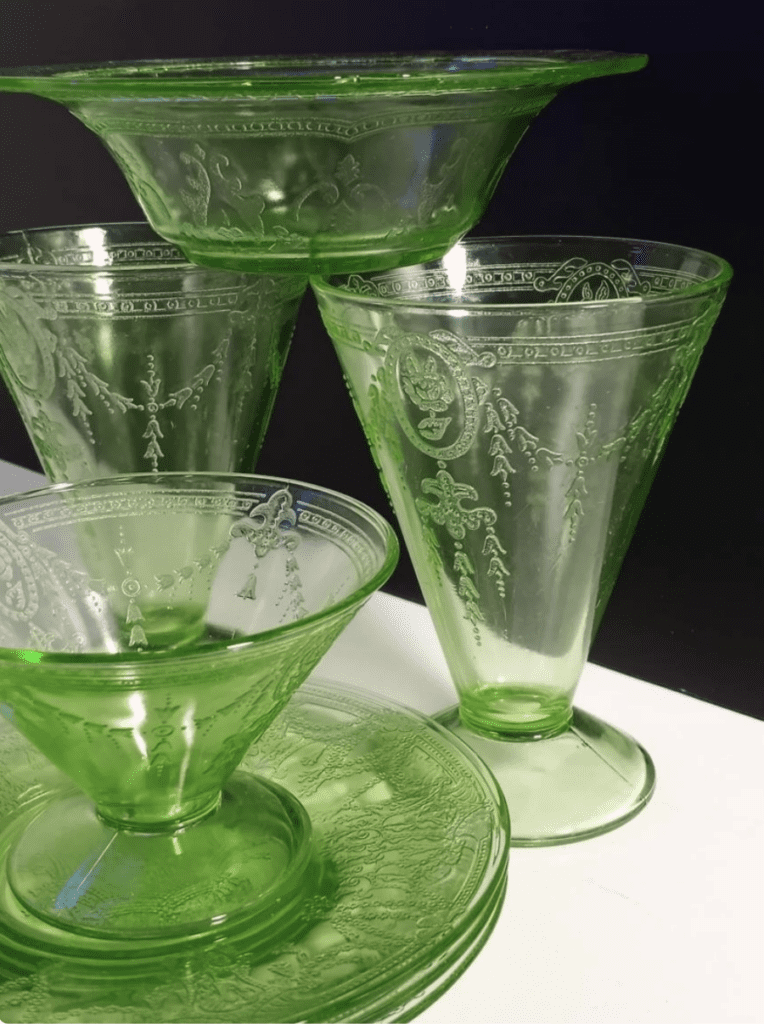
Other colors that are also a part of the depression glass club but not as popular are the following:
- Amethyst
- Black
- Crystal
- White
- Red
At the time of the Great Depression, yellow was a very popular color. Today, reproduction depression glass comes in a variety of colors, so make sure to keep that in mind if searching for authentic depression glass.
The most popular and easy-to-find designs are floral and geometric designs. Like their names suggest, these designs contain flowers, swirls, and even diamond patterns. These are super easy to recognize, but finding these dishes are only half of the search for original depression glass.
The other half of the search is to be certain that the piece you find is an original and not a reproduction.
How to Identify Depression Glass Against Look-Alikes
The best way to find out if the depression glass is actual depression glass or not comes down to one simple rule: search for flaws.
It’s an odd way to find out if it’s authentic or not, and it may sound too simple. However, if you think about it for a second, authentic and original pieces are never perfect, and these flaws are what make the pieces unique. Perfection is never original.
Scratches
Depression glass is clearly made of glass, and the glass made is fragile. So if one is searching for era-period depression glass, look for scratches. This is one of the most important things a person would want to look for. Depression glass was used commonly in everyday activities, so a lot of depression glass is found in the shape of dishes, such as dinnerware. If it’s a candy jar or a plate you’re seeking, look for scratches.
Glass Seams
Another common indicator of real depression glass is the seams of the glass, and the long, thin lines. To find the seams, look for overlapping ridges on the top. Reproductions do not have this feature. When the glass was being dried, the piece would be laid to dry on straw surfaces, which would make small imprints. Look for these, especially on the bottom of the dishes, which is where they will most likely be found.
Thickness
Thickness is another indicator. Original depression glass was thin and delicate because of the low cost of production. It can be difficult to find an original depression glass piece by using this indicator, even though reproductions are commonly much thicker because the originals varied in thickness (Source).
Bubbles
Another great tip is to look for bubbles. This is one of the most important features of real depression glass. On the surface of these dishes, such as a wineglass, there will be tiny bubbles in the glass. Another indicator of depression glass is its intricate designs. Though many patterns can be found on depression glass, the most popular designs include geometric and floral patterns.
Company Markings
Another unique thing about depression glass, which also happens to be a good indicator of whether or not a piece is original, is that most period depression glass is not marked by a company. This makes the story of each piece of original depression glass a beautiful mystery from one of the hardest times in American history.
Color Variation
Another factor to look for is an inconsistency in the color of the dish. Typically, the color won’t be the same shade all the way around and through the glass, as most modern glassware is. For example, if there is a wineglass that is the color blue, the bottom of the glass might be a darker shade of blue than the top (Source).
Depression Glass Patterns
Some of the most common patterns of depression glassware are the following:
- American Sweetheart
- Cameo
- Mayfair
- Princess
- Royal Lace
- Cherry Blossom
- Sunflower
- Patrician
American Sweetheart
American Sweetheart was one of the most popular patterns, and often found in pieces of depression glass made in softer, sweeter colors, like pink or blue. These American Sweetheart-patterned pieces commonly portrayed the designs of small plants and flowers, or paisley and curlicue patterns.
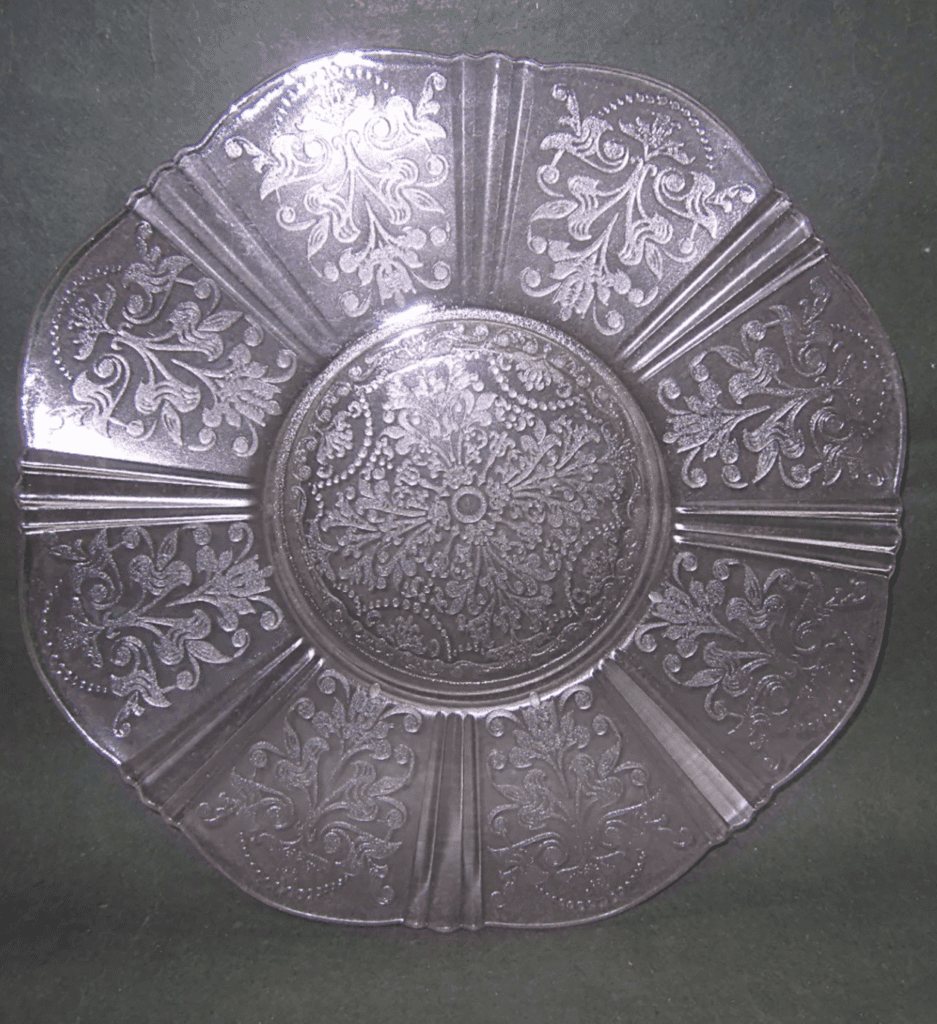
Cameo
Most Cameo depression glassware came in the color green and is rarely found in any other color, but it was occasionally made in pinks and yellows as well. The Cameo design looks like strings of beads or pearls have been stretched around the edges of the piece (Source). If found in green, it is much cheaper than it is when found in rarer colors, which cost much more because of their rarity. This pattern is also sometimes called “Ballerina” or “Dancing Girl”.

Mayfair
Mayfair was the pattern of flowers, and sometimes the term “Mayfair” was also interchanged with “Open Rose” because of the flowers which were large and beautiful, but few and far between. Depression glassware carrying the Mayfair pattern is mostly found in the color pink.
However, there were other colors associated with it as well, such as blue, yellow, and green. Blue Mayfair patterns are highly sought after because they’re so rare. This pattern was commonly found on pieces shaped like cookie jars.

Princess
Princess patterns on depression glass have a trademark feature on them, which is the scalloped edges. They were made by one of the biggest glass producers of this era: the Anchor Hocking Glass Company.
They were known for creating many of the popular patterns found on depression glass today: not just the Princess, but the Mayfair and Cameo patterns as well. The Princess pattern is most commonly found on glassware pieces that are pink, green, or an amber-yellow color.
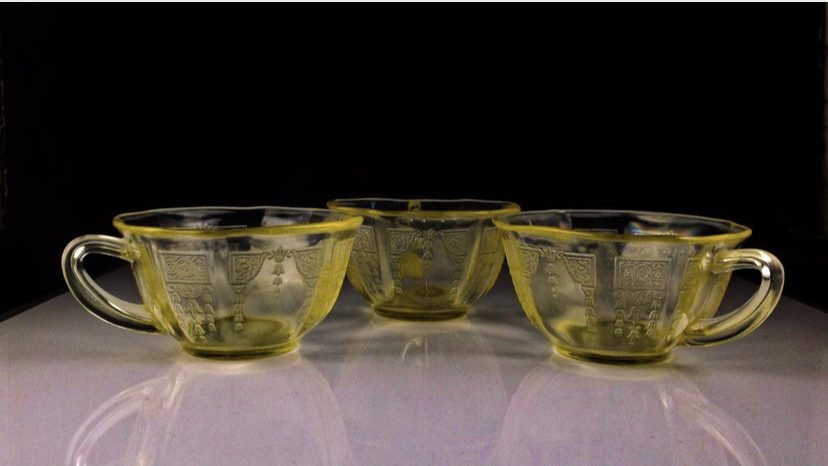
Royal Lace
The Royal Lace pattern, like its name suggests, looks positively regal. The simplicity of the design just screams elegance (but royalty never screams, so the pattern might just be the very picture of elegance). These patterns are usually found in cobalt blue, but green and pink are also very popular colors for this pattern to be featured on.
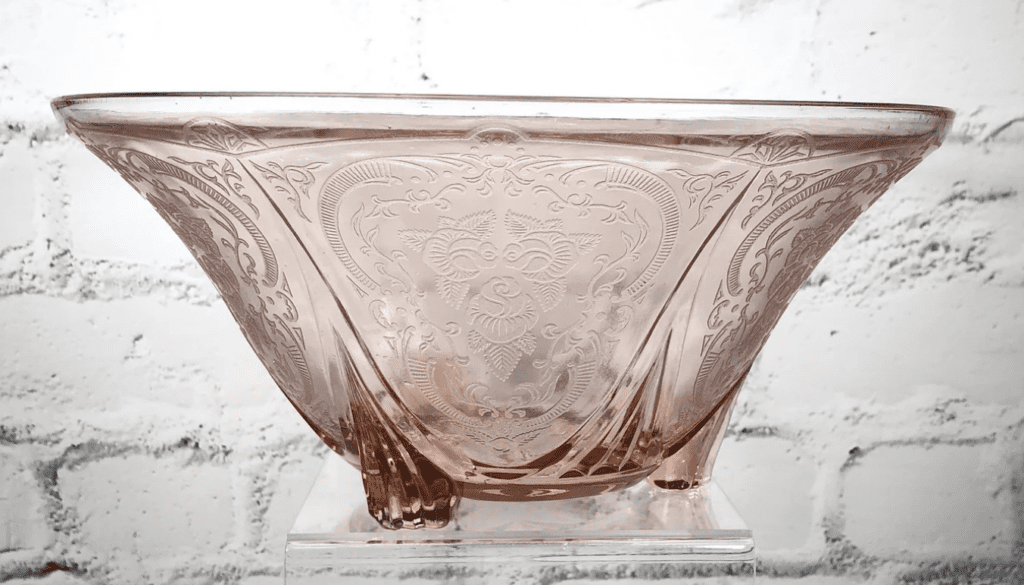
Cherry Blossom
The Cherry Blossom pattern came in all sorts of lighter colors like pink, green, and blue, and the pattern is even found on transparent pieces. The design on this particular pattern is lovely; interweaving leaves, blossoms, and cherries creating a delicate, feminine design.
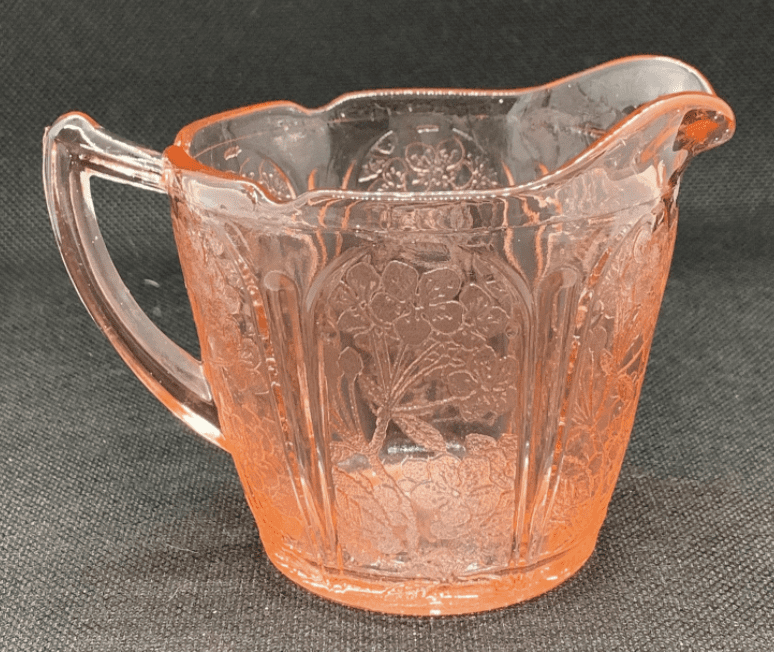
Sunflower
This is a fairly easy one to identify, as sunflowers are the main component of the design. It is reminiscent of a sunflower garden, with the flowers stretching up towards the sky. Pieces with this pattern came in a variety of colors, but are most commonly found in pink, green, and blue.
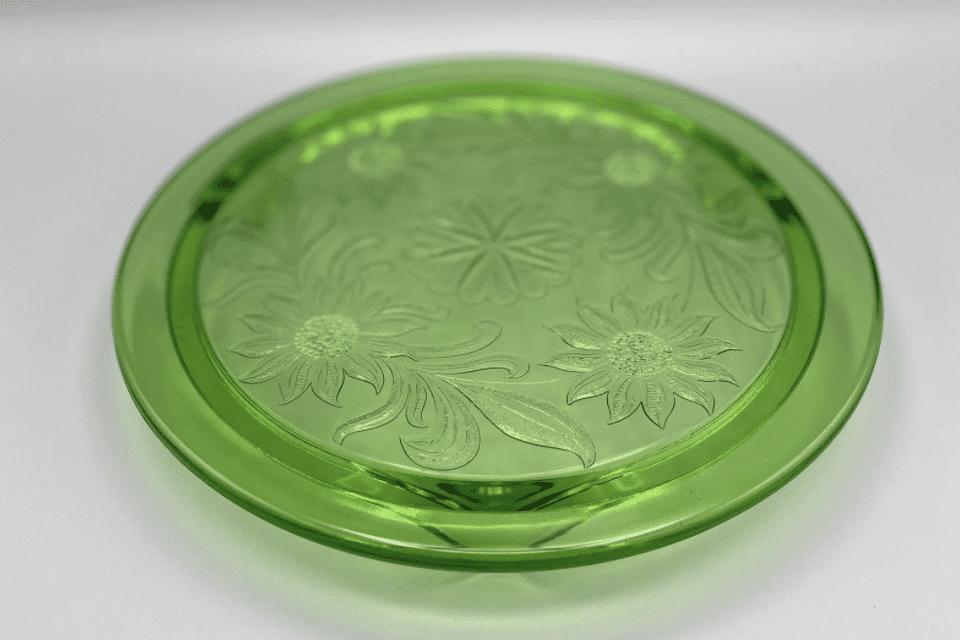
Patrician
The Patrician pattern, also called a “spoke” pattern, comes most often in favored colors of green, amber, and pink. The intricate lines and shapes suggest a delicate yet elegant, almost regal air.

(Source 1, Source 2, Source 3).
Below are some more patterns of depression glassware, though these are arguably not as popular as the ones listed above:
- Aurora
- Bubble pattern
- Doric
- Georgian
- Holiday
- Horseshoe
- Iris
- Madrid
- Moderntone
- Old Colony
- Pineapple and Floral
- “S” pattern
- Spiral
- Queen Mary
- Sharon
- Waterford
- Moonstone
Depression Glass Look-Alikes
Elegant glass is one type of glass that is commonly mistaken for depression glass. This type of glass, though, is made of higher quality glass. It has fewer visible seams, and it lacks the little bubbles and wrinkles typically found in pieces of depression glass, all of which lend to a more achievable elegant and finished look, hence the name.
Another type of glass that tends to be compared to depression glass is carnival glass. This type of glass doesn’t look too much like depression glass, because it has been treated to have a gorgeous iridescent sheen. This makes the colors fun and bright, just like a carnival. It is said that in the 1900s, instead of winning prizes like bears or basketballs, you’d win a carnival glassware piece after winning a game.
Some depression glass was made with uranium that makes it glow under UV light. Taking a small UV flashlight can be an excellent way to identify if the glass is from the Depression Era. If you’re thinking that uranium isn’t a good thing to have in a product that you will be using to eat, you may be right. There are lots of conflicting views on the internet, but if you want to stay as safe from radioactive materials as you can, eating off of depression glass is probably not a good idea.
Even if you take the safety problem out of the equation, you don’t want to risk breaking an original piece of depression glass by eating off of it, so if you want to keep your depression glass in top condition, leave it in a cabinet or display that young children can’t reach.
Resources for Depression Glass
There were seven major companies that had a lot of success in creating different styles and patterns in the making of depression glass (Source). Though these companies were very successful in their day, none of them have lasted into the new century for many reasons, including failing markets, natural disasters, and more.
- Jeannette Specialty Glass
- Hazel-Atlas Glass Company
- U.S. Glass Company
- Anchor-Hocking
- Federal Glass
- Indiana Glass Company
- Macbeth-Evans Glass Company
These producers had very similar ideas when it came to the design portion of the depression glass. Each of the designs was very appealing to customers and still is to the hundreds and thousands of collectors of original depression glassware.
Most of these companies did not brand their work, which might seem strange. But in truth, it’s actually a genius practice. Because companies specialized in certain patterns and designs, consumers were easily able to tell which pieces were made by which company. Therefore, glassware companies didn’t deem it necessary to mark their pieces.
For example, the Jeannette Specialty Glass Company’s most common patterns and designs were:
- Adam patterns
- Iris and Herringbone
- Cherry Blossom
- Hex Optic
- Cube (also known as Cubist)
- Sierra
- Doric
- Sunflower
- Sunburst
The Jeannette Specialty Glass company was known primarily for kitchenware, however, they also created a lot of children’s dishes. The company permanently closed in 1983, due to a failing American market.
The Hazel-Atlas Glass Company started as four separate companies: the Hazel Glass and Metals Company, the Atlas Glass Company, the Wheeling Metal Plant, and the Republic Glass Company. The companies merged together in 1902 to create the Hazel-Atlas Glass Company. They created everyday dinnerware at an inexpensive price, which was a relief for those living in the Depression. Some of Hazel-Atlas’s patterns are:
- Royal Lace
- Cloverleaf
- Newport
- New Century
- Colonial Block
The Royal Lace pattern was especially unique, as that particular pattern was featured on entire dinner sets, while most sets mixed and matched different patterns. Sadly, the Hazel-Atlas Glass Company shut down in 1964.

